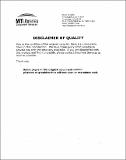Scaled electromechanical modeling of the F-35A Joint Strike Fighter
Author(s)
Marmorato, Leonardo F. (Leonardo Francesco), 1982-
DownloadFull printable version (4.426Mb)
Other Contributors
Massachusetts Institute of Technology. Dept. of Mechanical Engineering.
Advisor
Ernesto E. Blanco.
Terms of use
Metadata
Show full item recordAbstract
During the early 1990s, The U.S. Department of Defense embarked on a search for an affordable, next generation fighter aircraft that could fit the common needs of the Navy, Air Force, and Marines, as well as several allied nations. Lockheed Martin Corporation provided the answer with a cutting-edge fighter jet design that fulfilled all of the DoD's needs; the F-35 Joint Strike Fighter. The JSF was produced in three different variants, the first and simplest being the F-35A CTOL (Conventional Take-off, Landing), designed especially for the Air Force. In order to explore the underlying principles of the JSF's design as well as its aerodynamic characteristics, a scaled electromechanical model of the JSF F-35A variant was constructed using limited information about the aircraft's unclassified dimensions and features. The design process involved at first a CAD solid model of the entire structure. Once the computer-based model was completed, parts were manufactured with high precision out of 1/16" polycarbonate with the aid of a waterjet. The scaled model also had several electrical components such as an R/C transmitter and receiver, servos for controlling the aerodynamic surfaces; high speed ducted fan motor for providing the necessary thrust, and LEDs to mimic the aircraft's external lighting system. Despite some minor differences in detail, the F-35A 25:1 scaled model closely resembled most of the physical features contained in the Joint Strike Fighter conventional takeoff/landing variant. It should be made clear that the decision for making the airframe out of polycarbonate was greatly influenced by time limitations and budget constraints experienced throughout the term. Our original intention was to make the airframe completely out of balsa wood, (cont.) a material with a stiffness (E) similar to that of polycarbonate, yet up to eight times lighter. Nevertheless, the fact that balsa stock comes in relatively small sizes meant more time would be spent loading and unloading pieces on the waterjet. In general, having limited resources had a lot of leverage on our design approach, especially so when the cost for operating the waterjet at the LMP facilities was tagged at $100 per hour. It is then proposed as a side project to build the same model out of balsa for flying purposes in the near future.
Description
Thesis (S.B.)--Massachusetts Institute of Technology, Dept. of Mechanical Engineering, 2004. "June 2004." Includes bibliographical references.
Date issued
2004Department
Massachusetts Institute of Technology. Department of Mechanical EngineeringPublisher
Massachusetts Institute of Technology
Keywords
Mechanical Engineering.